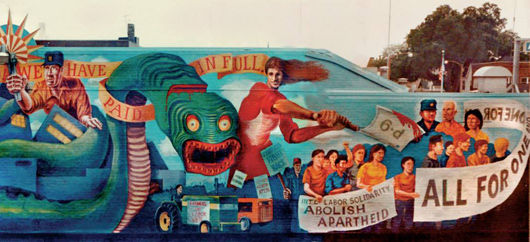
Thirty years ago on this date, August 17, 1985, 1500 members of Local P-9, United Food and Commercial Workers Union (UFCW), struck the Hormel meatpacking plant in Austin, Minn. The strike began as an economic struggle by workers to defend their standard of living and fight against giving further concessions to a profit-rich company. It ended as a bitter conflict that galvanized workers’ support from around the country and internationally.
Hormel Foods Corporation, an American food company that produces Spam luncheon meat, was founded in Austin in 1891. Hormel sells food under many brands, including Dinty Moore, Farmer John, Lloyd’s, Muscle Milk, Skippy, La Victoria and Stagg, as well as under its own name. The company is listed on the Fortune 500.
The UFCW was created through the merger of the Amalgamated Meat Cutters union and Retail Clerks International Union (RCIU) following its founding convention in June 1979. William H. Wynn, president of the RCIU and one of the merger leaders, became president of UFCW. The merger created the largest union affiliated with the AFL-CIO. The UFCW continued to expand both by organizing and merging with several smaller unions between 1980 and 1998.
Very shortly the mettle of the union was forced into severe tests. These were the years of union-busting President Ronald Reagan. In the early 1980s, recession impacted several meatpacking companies, decreasing demand and increasing competition, which led smaller companies to go out of business. In an effort to keep plants from closing, many instituted wage cuts. Wilson Food Company declared bankruptcy in 1983, allowing them to cut wages from $10.69 to $6.50 and significantly reduce benefits.
Hormel had avoided such drastic action until 1985. Workers had already labored under a wage freeze and dangerous working conditions, leading to many cases of repetitive strain injury. When Hormel demanded a 23 percent wage cut, the workers decided to strike. It became one of the longest strikes of the 1980s.
The strike was declared by Local P-9, but the UFCW parent union did not support it. The UFCW ultimately struck a deal with Hormel management, seized control of Local P-9, and removed the local union leaders, actions that challenged the credibility of the UFCW in the eyes of many in the larger labor movement. The strike gained national attention and led to a widely publicized boycott of Hormel products.
After six months, a significant number of strikebreakers crossed the picket line, provoking a vigorous response. On January 21, 1986, Minn. Gov. Rudy Perpich called in the National Guard to protect the strikebreakers. This brought protests against the governor, and the National Guard withdrew.
The strike ended in June 1986, after 10 months. Over 700 of the workers did not return to their jobs, refusing to cross the picket line. In solidarity with those workers, the boycott of Hormel products continued for some time. Ultimately, the company succeeded in hiring new workers at significantly lower wages.
The strike was chronicled in the film American Dream, which won the Academy Award for best documentary in 1990. A song about the strike, entitled “P-9,” was written by Dave Pirner of the Minneapolis band Soul Asylum. The song was included on their 1989 album “Clam Dip & Other Delights.”
The strike also had a Harvard Business School Case written based on it (with assumed names), called “Adam Baxter Co./Local 190,” which features multiple rounds of negotiations between unions and management.
In the course of their struggle, the P-9ers took on Hormel, the local authorities, the courts, the press, their own national, and the National Guard. The union mobilized its members in a display of democracy not seen in the labor movement for many years. Union activists poured into Austin to participate in the pickets, demonstrations and rallies. It became a fight for the rank and file throughout the nation.
Many strikers’ lives became transformed. As they entered into the field of political activity, these “typical workers” became class-struggle militants, willing to face jails and bullets in their fight for social justice. They learned to look beyond their own narrow economic interests, viewing their struggle as part of an international movement of workers against all their employers.
In the midst of the fray, a P-9 leader, Denny Mealy, and muralist Mike Alewitz led the workers in painting an exuberant mural on their union hall which came to symbolize the strike. The union dedicated the mural to then-imprisoned Nelson Mandela, at a time when he was still being vilified as a terrorist by Reagan’s government.
After the strike ended, the national union wiped out the memory of the historic struggle by sandblasting the mural off the wall. By October of 1986 it was gone. The green dragon of capitalism featured in the mural was recreated by Alewitz in another mural commissioned in 1990 for the Southern California Library for Social Studies and Research in Los Angeles, and still exists.
Adapted from UFCW, Wikipedia, and a memoir by the artist Mike Alewitz.
Photo courtesy of the artist Mike Alewitz; for a more complete view of the pic, see here.










